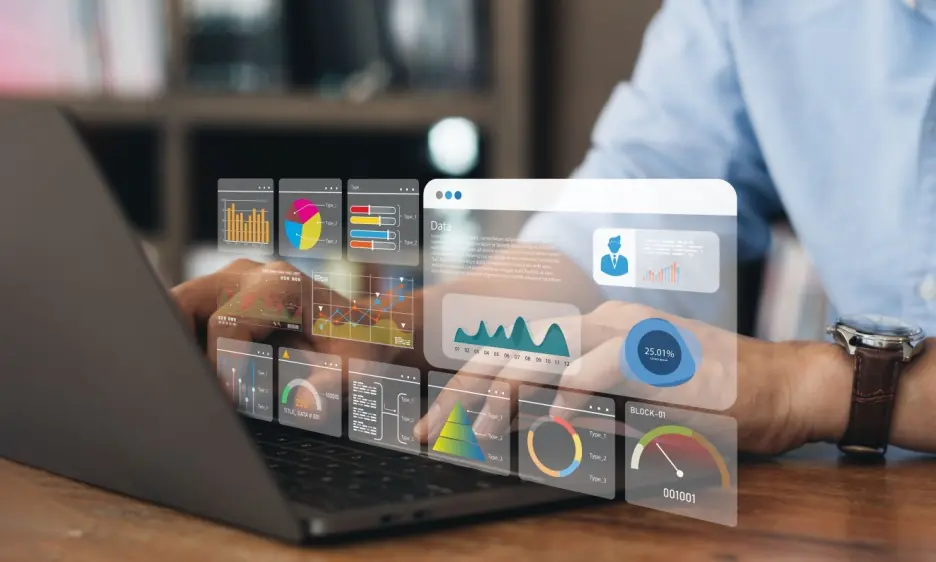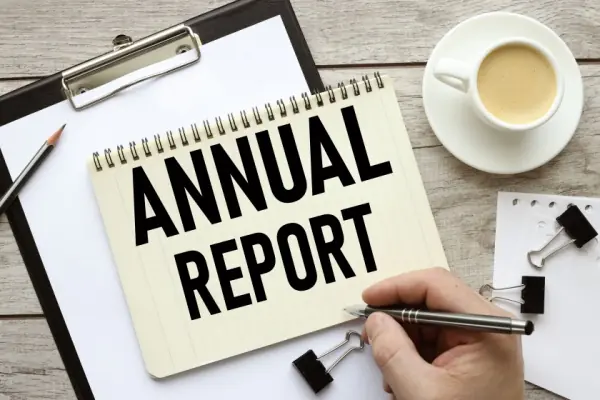Using Amazing Storytelling with Data to Enhance Annual Reports
 Share
Share
 Copy Url
Copy Url

Storytelling with data transforms the annual report of any company from a mundane task into a compelling narrative. While it's a rule for many businesses, an annual report doesn't have to be a tedious compilation of facts and figures. Instead, it presents a unique opportunity to communicate your brand's essence and achievements. Through the lens of annual report storytelling, you can make your company's story resonate with your audience, showcasing what you do and why it matters. This approach breathes life into your data, making it more than numbers on a page.
Unfortunately, many companies still produce annual reports that feel stuck in the past. Too often, these are reminiscent of the 1990s with their standard templates and endless pages of text. This is where data storytelling for business comes into play. By integrating data storytelling in annual reports, you transform dry statistics into engaging narratives. These reports don't only list facts. They weave a narrative that captures the brand's personality and connects with readers on an emotional level. Let's explore how storytelling with data can elevate your annual reports, making them not only informative but also inspirational and engaging.

What is Storytelling with Data?
Storytelling with data is a powerful technique that goes beyond mere numbers and charts. It's about crafting a narrative that makes data come alive. This method is especially crucial in annual report storytelling, where the goal is to showcase a company's yearly achievements in a way that's engaging and easy to understand.
In the business world, companies use storytelling with data to share their success stories and challenges. This method resonates with stakeholders, making the information more impactful. It's not only about presenting raw data. It's about crafting compelling stories from data that illustrate growth, highlight achievements, and outline future goals. These narratives showcase the company's journey, emphasizing its progress and objectives.
Let's say you use storytelling with data in your business's annual reports. This method changes the reports from numbers and stats into an exciting story about the year. It makes the data easy to understand and interesting, helping businesses share their message and connect with people. Instead of showing numbers, companies can tell a story. This approach makes their presentation useful and memorable. It can also move and inspire the audience.
Storytelling With Data Examples
Storytelling with data is a skill that turns complex information into engaging narratives. Let's explore how different types of visual data representations can tell a story, capturing the audience's attention and aiding in decision-making.
1. Sales Growth Timeline
This example of data storytelling shows a company's sales progress over time. The company can use a timeline to show its sales figures. This timeline shows trends, big growth times, or tough periods. It makes the data simple and helps people understand the company's path. This understanding leads to better decisions.
2. Customer Journey Map
This tool visualizes the path a customer takes with a product or service. It's a great way to tell a story about user experience, identifying touchpoints where customers interact with the brand. Companies use this map to make data-driven decisions to enhance customer satisfaction and loyalty.
3. Financial Performance Dashboard
This dashboard shows how a company is doing financially. It uses storytelling with data to share its money situation. The dashboard mixes different money-related numbers to give a quick look at how things are going. This is very important when telling stories in annual reports.
4. Marketing Funnel Analysis
This analysis breaks down the steps a customer takes from awareness to purchase. This narrative helps companies see how well they are turning potential customers into actual buyers. It guides them in making smart marketing choices.
5. Comparative Market Share Chart
By displaying competitors' market shares alongside each other, this chart tells a story of competitive positioning. It helps businesses identify where they stand in the market and plan accordingly.
6. Sentiment Analysis Word Cloud
This visual shows what people think or feel, based on their feedback. The size of the words shows how often they come up or how important they are. This storytelling method points out the main things customers are saying. It gives clues about how people see the company.
7. Supply Chain Flowchart
This flowchart tells the story of how a product moves from conception to delivery. It's crucial for identifying bottlenecks and optimizing the supply chain process, ensuring efficiency and cost-effectiveness.
8. Website User Interaction Heatmap
This heatmap shows where users click, scroll, and interact on a website. It tells a story of user behavior, guiding improvements in website design and functionality to enhance user experience.
9. Project Development Storyboard
This storyboard outlines the steps or phases in a project, narrating the progress from start to finish. It's a visual story that helps teams stay aligned and informed about project milestones and status.
10. Infographic Summary
An infographic summarizes complex data or information in a visually engaging way. It uses storytelling with data to distill key points, making them easily digestible for the audience and effective for communication.
11. Social Network Relationship Map
This map shows how people or things are connected in a network. It shows how they interact and influence each other. This helps us understand how the network works and find out who the main influencers are.
12. Demographic Pictorial Chart
This chart uses images or icons to represent demographic data, making it easier to comprehend and relate to. It's a form of data storytelling that communicates population characteristics in a visually appealing and straightforward manner.
13. Animated Growth Chart
An animated chart shows changes over time, capturing the audience's attention with movement. It's a dynamic way to tell a story of progression, regression, or cyclical trends, making the data more engaging and memorable.
14. Circular Market Share Chart
This chart shows who has what share of the market, but it does it in a circular format. This is different from the conventional bar or pie charts. It helps tell a story by showing how different companies relate to each other and gives a full picture of who controls the market.
These examples show how data storytelling can teach you the basics. It helps you turn plain numbers into interesting stories. This grabs people's attention and shares important messages clearly.
How Does Storytelling with Data Enhance Your Annual Report?
Storytelling with data isn't only about numbers. It's more about crafting a narrative that enhances how people perceive and understand your annual and corporate reports. Let's dive into how this approach can transform your reports.
Building Trust in Your Business Practices
Using storytelling with data in your reports helps build trust. When you present data in a story format, it's not only numbers. It becomes a narrative of your company's integrity and reliability. This method makes data easy to interpret, showing stakeholders how your business operates and makes decisions. It's a key aspect of annual report storytelling, as it reassures investors and customers about your company's commitment to transparency and ethical practices.
Uniting People Around Shared Values
Storytelling with data brings employees, investors, and customers together around what your company stands for. When you tell stories with data in your reports, everyone gets on the same page. It's attention-grabbing and builds a sense of togetherness and shared goals. It shows that your company's actions match its values.
Highlighting the People Behind Your Brand
Data storytelling in annual reports lets you showcase the individuals who drive your company's success. It transforms statistics about team performance, customer service, or innovation into relatable narratives. This humanizes your brand, making stakeholders feel closer to your team and more invested in their stories. It's a way to effectively communicate the human element of your business, emphasizing that behind every data point is a person contributing to your brand's journey.
Making Your Story Memorable
When you tell a story with data, you make your company's narrative stickier. People are more likely to remember information when it's presented as a story than as raw data. Using stories in your reports makes it easier for people to remember what your company has done and faced. It makes the reports more interesting and useful. These stories help people make decisions because they remember the details better and understand what they mean for your company.
Igniting Excitement for the Future
Storytelling with data gets people excited about where your company is headed. When your reports talk about what the company plans to do and what it could achieve, it gets people excited. They see not only what the company is doing now but also what it could do in the future. This excitement might make more people want to invest, work for, or stay loyal to your company. It shows that your company is looking ahead, not just at today.
Storytelling with data is a way to teach you the basics of sharing information effectively. It turns your reports from plain data sheets into engaging stories that grab people's attention and give them valuable insights.
How To Tell A Story With Data?
Storytelling with data can transform your annual and corporate reports from mundane documents into captivating narratives. Let's explore how to harness this power, step-by-step, to enhance your reports.
Step 1: Know Your Audience
First, understand who will read your report. Knowing your audience helps you tailor the story you're telling with data. It ensures the information is relevant and presented in a way that resonates, making your annual report storytelling more effective and engaging.
Step 2: Define Your Goal
What do you want to achieve with your report? Clearly defining your objective helps focus your storytelling with data, guiding you to emphasize the right aspects of your data storytelling in annual reports, enhancing clarity and impact.
Step 3: Select the Right Data
Choosing specific data that aligns with your goals is crucial. This ensures that the data you present supports your story, making it more convincing and relevant. This step is fundamental in learning how to make data tell a story.
Step 4: Build a Strong Structure
A compelling structure helps guide your audience through the data narrative. This organization is key to making your report both informative and memorable, enhancing the power of storytelling in your communication.
Step 5: Visualize Data Clearly
Effective data visualization is essential. It turns complex data into understandable and engaging visuals, aiding in the visualization and how to communicate your message clearly in the real world.
Step 6: Humanize Your Story
Incorporate elements that connect on a human level. Telling a human story within your data helps build an emotional connection, making the information more relatable and impactful.
Step 7: Add Context
Context makes your data meaningful. By providing background and explanations, you give your audience a fuller understanding, which is crucial for credibility in your data narrative.
Step 8: Simplify
Complexity can overwhelm and confuse. Keep your data presentation simple and straightforward, ensuring your message is clear and accessible to all audience members.
Step 9: Interactive Elements
Interactivity can make your report more engaging. Allowing users to explore data themselves helps sustain interest and can provide deeper insights, making your storytelling with data more dynamic.
Step 10: Iterate and Improve
Practice and refinement are key. Continuously refining your approach to data storytelling teaches you the fundamentals and nuances of how to effectively communicate with data, enhancing the quality and clarity of your reports.
By following these steps, you can navigate through the process of storytelling with data, making your annual and corporate reports not just informative but also compelling narratives that engage and inform your audience.
Storytelling with Data VS Data Visualizations - Are They The Same?
Storytelling with data and data visualization might seem similar, but they're not the same. Data visualization is a key part of storytelling with data, especially in areas like annual report storytelling. It's about showing data in a way that's easy to understand. Think of it as the building block in data storytelling in annual reports. It helps people see what's going on with the numbers.
Now, storytelling with data goes a step further. It's not just showing data; it's about telling a story with it. This includes setting up a narrative, explaining changes, and showing why the data matters. It makes the data stick in people's minds. Cole Nussbaumer Knaflic highlights this by showing how storytelling adds depth to data, making your message more powerful.
In business, using data visualization for business helps share information. But to communicate effectively with data, you need storytelling. It brings credibility and a memorable context to the numbers. So, while data visualization shows the data, storytelling with data gives it meaning and connects it to the real world.
Report Yak - The No.1 Choice for Storytelling with Data in Every Annual Report
Storytelling with data is a transformative approach that elevates annual and corporate reports from mere collections of numbers to compelling narratives. This technique enables companies to illustrate their achievements, growth, and future aspirations in a way that is both engaging and accessible. By weaving data into a story, businesses can connect with their audience on a deeper level, making the information more memorable and impactful. Through storytelling, data becomes a powerful tool to communicate a company's journey, values, and vision, making every report a unique opportunity to showcase the brand's story.
Looking to enhance your annual reports with the magic of storytelling with data? Report Yak is here to help. As the leading report design agency in India, we specialize in crafting annual reports, sustainability reports, ESG reports, and more, that resonate with audiences worldwide. Our team of expert content writers and designers understands the significance of storytelling with data, ensuring that every report we create not only communicates effectively but also connects emotionally with your audience. Whether you're in India or anywhere around the globe, trust Report Yak to bring your data to life in the most engaging way. Check out our Showcase page on the Report Yak website to see our work and discover how we can transform your reports into captivating stories. Call us at 1800 121 5955 (India) or email at contact@reportyak.com for more information.
Related Posts
-
The Importance of Closed Loop Systems in Sustainability Reporting
Annual Report designAnnual reports
+8
Oct 4, 2024Share
Copy Url
Circular Economy Approach to Plastic Waste for Sustainability
Sep 25, 2024Share
Copy Url
Half-Yearly Reports: What Makes Them So Important?
Annual Report designcorporate reporting
+6
Sep 19, 2024Share
Copy Url






